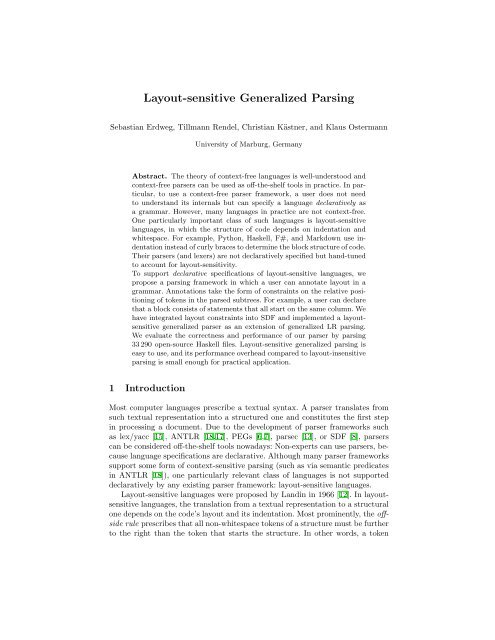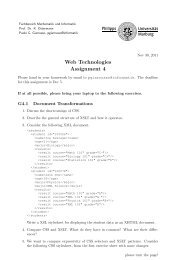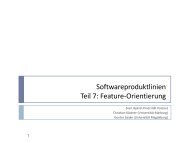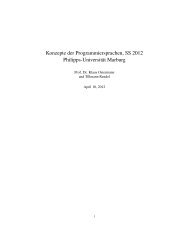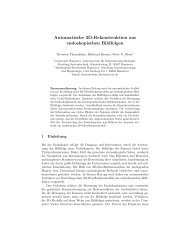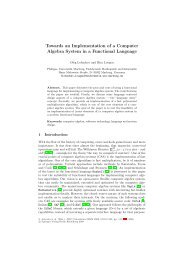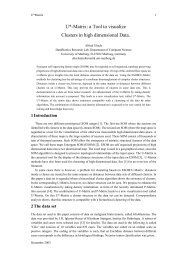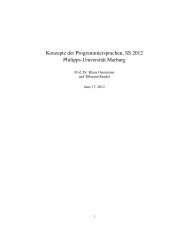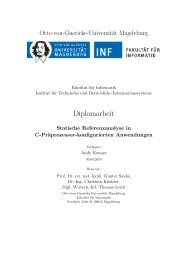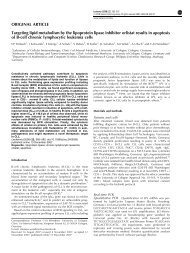Layout-sensitive Generalized Parsing
Layout-sensitive Generalized Parsing
Layout-sensitive Generalized Parsing
Create successful ePaper yourself
Turn your PDF publications into a flip-book with our unique Google optimized e-Paper software.
<strong>Layout</strong>-<strong>sensitive</strong> <strong>Generalized</strong> <strong>Parsing</strong>Sebastian Erdweg, Tillmann Rendel, Christian Kästner, and Klaus OstermannUniversity of Marburg, GermanyAbstract. The theory of context-free languages is well-understood andcontext-free parsers can be used as off-the-shelf tools in practice. In particular,to use a context-free parser framework, a user does not needto understand its internals but can specify a language declaratively asa grammar. However, many languages in practice are not context-free.One particularly important class of such languages is layout-<strong>sensitive</strong>languages, in which the structure of code depends on indentation andwhitespace. For example, Python, Haskell, F#, and Markdown use indentationinstead of curly braces to determine the block structure of code.Their parsers (and lexers) are not declaratively specified but hand-tunedto account for layout-sensitivity.To support declarative specifications of layout-<strong>sensitive</strong> languages, wepropose a parsing framework in which a user can annotate layout in agrammar. Annotations take the form of constraints on the relative positioningof tokens in the parsed subtrees. For example, a user can declarethat a block consists of statements that all start on the same column. Wehave integrated layout constraints into SDF and implemented a layout<strong>sensitive</strong>generalized parser as an extension of generalized LR parsing.We evaluate the correctness and performance of our parser by parsing33 290 open-source Haskell files. <strong>Layout</strong>-<strong>sensitive</strong> generalized parsing iseasy to use, and its performance overhead compared to layout-in<strong>sensitive</strong>parsing is small enough for practical application.1 IntroductionMost computer languages prescribe a textual syntax. A parser translates fromsuch textual representation into a structured one and constitutes the first stepin processing a document. Due to the development of parser frameworks suchas lex/yacc [15], ANTLR [18,17], PEGs [6,7], parsec [13], or SDF [8], parserscan be considered off-the-shelf tools nowadays: Non-experts can use parsers, becauselanguage specifications are declarative. Although many parser frameworkssupport some form of context-<strong>sensitive</strong> parsing (such as via semantic predicatesin ANTLR [18]), one particularly relevant class of languages is not supporteddeclaratively by any existing parser framework: layout-<strong>sensitive</strong> languages.<strong>Layout</strong>-<strong>sensitive</strong> languages were proposed by Landin in 1966 [12]. In layout<strong>sensitive</strong>languages, the translation from a textual representation to a structuralone depends on the code’s layout and its indentation. Most prominently, the offsiderule prescribes that all non-whitespace tokens of a structure must be furtherto the right than the token that starts the structure. In other words, a token
if x != y:if x > 0:y = xelse:y = -x(a) Python: Indentation resolvesthe dangling else problem.do input do putStrLn ”thank you”sendToServer txtreturn TrueNothing -> fail ”no input”(b) Haskell: Nested block structure.Fig. 1. <strong>Layout</strong>-<strong>sensitive</strong> languages use indentation instead of curly braces.is offside if it occurs further to the left than the starting token of a structure;an offside token must denote the start of the next structure. In languages thatemploy the offside rule, the block structure of code is determined by indentationand layout alone, whose use is considered good style anyway.The offside rule has been applied in a number of computer languages includingPython, Haskell, F#, and Markdown. The Wikipedia page for the off-siderule 1 lists 20 different languages that apply the offside rule. For illustration,Figure 1 shows a Python and a Haskell program that use layout to declare thecode’s block structure. The layout of the Python program specifies that the elsebranch belongs to the outer if statement. Similarly, the layout of the Haskell programspecifies to which do-block each statement belongs. Unfortunately, currentdeclarative parser frameworks do not support layout-<strong>sensitive</strong> languages such asPython or Haskell, which means that often the manually crafted parsers in compilersare the only working parsers. This makes it unnecessarily hard to extendthese languages with new syntax or to create tools for them, such as refactoringengines or IDEs.Our core idea is to declare layout as constraints on the shape and relativepositioning of syntax trees. These layout constraints occur as annotations of productionsin the grammar and restrict the applicability of annotated productionsto text with valid layout. For example, for conditional expressions in Python,we annotate (among other things) that the if keyword must start on the samecolumn as the else keyword and that all statements of a then or else branch mustbe further indented than the if keyword. These latter requirements are context<strong>sensitive</strong>,because statements are rejected based on their appearance within aconditional statement. Thus, layout constraints cannot be fully enforced duringthe execution of a context-free parser.We developed an extension of SDF [8] that supports layout constraints. Thestandard parsing algorithm for SDF is scannerless generalized LR parsing [21].In a generalized parsing algorithm, all possible parse trees for an input stringare processed in parallel. One approach to supporting layout would be to parsethe input irrespective of layout in a first step (generating every possible parse1 http://en.wikipedia.org/w/index.php?title=Off-side_rule&oldid=517733101
tree), and then in a second step discard all syntax trees that violate layoutconstraints. However, we found that this approach is not efficient enough forpractical applications: For many programs, the parser fails to terminate within30 seconds. To improve performance, we identified a subset of layout constraintsthat in fact does not rely on context-<strong>sensitive</strong> information and therefore can beenforced at parse time. We found that enforcing these constraints at parse timeand the remaining constraints at disambiguation time is sufficiently efficient.To validate the correctness and to evaluate the performance of our layout<strong>sensitive</strong>parser, we have build layout-<strong>sensitive</strong> SDF grammars for Python andHaskell. In particular, we applied our Haskell parser to all 33 290 Haskell filesin the open-source repository Hackage. We compare the result of applying ourparser to applying a traditional generalized parser to the same Haskell fileswhere block structure has been made explicit through curly braces. Our studyempirically validates the correctness of our parser and shows that our layout<strong>sensitive</strong>parser can compete with parsers that requires explicit block structure.We make the following contributions:– We identify common idioms in existing layout-<strong>sensitive</strong> languages. Based onthese idioms, we design a constraint language for specifying layout-<strong>sensitive</strong>languages declaratively.– We identify context-free layout constraints that can be enforced at parsetime to avoid excessive ambiguities.– We implement a parser for layout-<strong>sensitive</strong> languages based on an existingscannerless generalized LR parser implementation in Java.– We extended existing layout-in<strong>sensitive</strong> SDF grammars for Python and Haskellwith layout constraints.– We evaluate the correctness and performance of our parser by parsing 33 290open-source Haskell files and comparing the results against parse trees producedfor Haskell files with explicit block structure. Our evaluation suggeststhat our parser is correct and fast enough for practical application.Our parser, grammars, and raw evaluation data are open-source and availableonline at http://github.com/seba--/layout-parsing. While our parser implementationis based on a scannerless parser, the ideas presented in this paperare applicable to parsers with separate lexers as well.2 <strong>Layout</strong> in the wildMany syntactic constructs in the programming language Haskell use layout toencode program structure. For example, the do-Block in the simple Haskell programin Figure 2(a) contains three statements which are horizontally aligned atthe same column in the source code. We visualize the alignment by enclosingthe tokens that belong to a statement in a box. More generally, a box enclosescode corresponding to a subtree of the parse tree. The exact meaning of theseboxes will become clear in the next section, where they form the basis of ourconstraint language.
main = do print 16print (11 + 12)print 42(a) Three statements withcorrect vertical alignment.main = do print 16print (11 + 12)print 42(b) Wrong parse: Statementshave to begin inthe same column, henceprint 42 cannot be a statement.main = do print 16print (11 + 12)print 42(c) Correct parse: Onlytwo statements, where thesecond print is applied tothree arguments.Fig. 2. Simple Haskell programs.A Haskell parser needs to check the alignment of statements to produce correctparse trees. For example, Figure 2(b) displays an incorrect parse tree thatwrongly identifies print 42 as a separate statement, even though it is further indentedthan the other statements. Figure 2(c) visualizes the correct parse treefor this example: A do-Block with two statements. The second statement spanstwo lines and is parsed as an application of the function print to three arguments.In order to recognize program structure correctly, a parser for a layout-<strong>sensitive</strong>language like Haskell needs to distinguish programs as in Figure 2(a) from programsas in Figure 2(c).It is not possible to encode this difference in a context-free grammar, becausethat would require counting the number of whitespace characters in additionto keeping track of nesting. Instead, many parsers for layout-<strong>sensitive</strong>languages contain a handwritten component that keeps track of layout and informsa standard parser for context-free languages about relevant aspects oflayout, for instance, by inserting special tokens into the token stream. For example,the Python language specification 2 describes an algorithm that preprocessesthe token stream to delete some newline tokens and insert indent and dedenttokens when the indentation level changes. Python’s context-free grammar assumesthat this preprocessing step has already been performed, and uses theadditional tokens to recognize layout-<strong>sensitive</strong> program structure.This approach has the advantage that a standard parser for context-freelanguages can be used to parse the preprocessed token stream, but it has thedisadvantage that the overall syntax of the programming language is not definedin a declarative, human-readable way. Instead, the syntax is only defined in termsof a somewhat obscure algorithm that explicitly manipulates token streams.This is in contrast to the success story of declarative grammar and parsingtechnology [11].Furthermore, a simple algorithm for layout-handling that informs a standardparser for context-free languages is not even enough to parse Haskell. The Haskelllanguage specification describes that a statement ends earlier than visible fromthe layout if this is the only way to continue parsing [14]. For example, the Haskellprogram in Figure 3(a) is valid: The statement print (11 + 12) only includes one2 http://docs.python.org/py3k/reference/
catch ( do print 16print(11 +12) )(\e -> do putStr "error: "print e )(a) Exception handler.catch ( do print 16print (11 +12) ) (\e -> doputStr "error: "print e )(b) Means the same as (a).Fig. 3. Both variants of this more complicated Haskell program have valid layout.closing parenthesis, because the second closing parenthesis cannot be consumedinside the statement. An algorithm for layout handling could not decide whereto end the statement by counting whitespace characters only. Instead, additionalinformation from the context-free parser is needed to decide that the statementneeds to end because the next token cannot be consumed. As a second andmore extreme example, consider the program in Figure 3(b) that has the sameparse tree as the program in Figure 3(a). In particular, the statements belong todifferent do-blocks even though they line up horizontally. These two programscan only be parsed correctly by close cooperation between the context-free part ofthe parser and the layout-<strong>sensitive</strong> part of the parser, which therefore have to betightly integrated. This need for tight integration further complicates the picturewith low-level, algorithmic specifications of layout rules prevalent in existinglanguage specifications and implementations.In this section, we have focused our investigation of layout-<strong>sensitive</strong> languageson Haskell and Python, but we believe our box model is general enough to explainlayout in other languages as well.3 Declaring layout with constraintsOur goal is to provide a high-level, declarative language for specifying and implementinglayout-<strong>sensitive</strong> parsers. In the previous section, we have discussedlayout informally. We have visualized layout by boxes around the tokens thatbelong to a subtree in Figures 2 and 3. We propose (i) to express layout rulesformally as constraints on the shape and relative positioning of boxes and (ii) toannotate productions in a grammar with these constraints. The idea of layoutconstraints is that a production is only applicable if the parsed text adheres tothe annotated constraint.For example, Figure 4 displays an excerpt from our grammar for Haskellthat specifies the layout of Haskell do-blocks with implicit (layout-based) as wellas explicit block structure. This is a standard SDF grammar except that someproductions are annotated with layout constraints. For example, the nonterminalImpl stands for implicit-layout statements, that is, statements of the form(but not or ). The layout constraint layout(”1.first.col < 1.left.col”) formallyexpresses the required shape for subtree number 1.
context-free syntaxStm -> Impl {layout("1.first.col < 1.left.col")}Impl -> ImplsImpl Impls -> Impls {cons("StmSeq"), layout("1.first.col == 2.first.col")}Stm -> ExplsStm ";" Expls -> Expls {cons("StmSeq")}Impls -> Stms {cons("Stms")}"{" Expls "}" -> Stms {cons("Stms"), ignore-layout}"do" Stms -> Exp {cons("Do"), longest-match}Fig. 4. Excerpt of our layout-<strong>sensitive</strong> Haskell grammar. Statements with implicit layout(Impl) have to follow the offside rule. Multiple statements have to align horizontally.Statements with explicit layout (Expl) are not layout-<strong>sensitive</strong>.tree ::= numbertok ::= tree.first | tree.left | tree.right | tree.lastne ::= tok.line | tok.col | ne + ne | ne - nebe ::= ne == ne | ne < ne | ne > ne | be && be | be || be | !bec ::= layout(be) | ignore-layoutFig. 5. Syntax of layout constraints c that can annotate SDF productions.We provide the full grammar of layout constraints in Figure 5. <strong>Layout</strong> constraintscan refer to direct subtrees (including terminals) of the annotated productionthrough numerical indexes.Each subtree exposes its shape via the source location of four tokens inthe subtree, which describe the relevant positions in the token stream. <strong>Layout</strong>constraints use token selectors to access these tokens: first selects the firstnon-whitespace token, last selects the last non-whitespace token, left selects theleftmost non-whitespace token that is not on the same line as the first token,and right selects the rightmost non-whitespace token that is not on the same lineas the last token. Figure 6(a) shows how the positions of these tokens describethe shape of a subtree.It is essential in our design that layout rules can be described in terms of thelocations of these four tokens, because this provides a declarative abstractionover the exact shape of the source code. As is apparent from their definition,the token selectors left and right fail if all tokens occur in a single line. Since asingle line of input satisfies any box shape, we do not consider this a constraintviolation.For each selected token, the position selectors line and col yield the token’sline and column offset, respectively. Hence the constraint 1.first.col < 1.left.colspecifies that the left border of the shape of subtree 1 must look like . In otherwords, the constraint 1.first.col < 1.left.col corresponds to Landin’s offside rule.Consider the following example:
1.last.col< 1.right.col1.last.col== 1.right.col1.last.col> 1.right.colfirstcatch ( do print 16print (11 +12) )lastwhitespace leftright(a) The source locations of four tokensinduce (an abstraction of) the shape ofa subtree.1.first.col< 1.left.col1.first.col== 1.left.col1.first.col> 1.left.col(b) <strong>Layout</strong> constraints to restrict theshape of a box.Fig. 6. Example layout constraints and the corresponding boxes.print (11 + 12)* 13Here, the constraint 1.first selects the first token of the function application,yielding the character p for scannerless parsers, or the token print otherwise. 1.leftselects the left-most token not on the first line, that is, the operator symbol *.This statement is valid according to the Impl production because the layoutconstraint is satisfied: The column in which print appears is to the left of thecolumn in which * appears. Conversely, the following statement does not adhereto the shape requirement of Impl because the layout constraint fails:print (11 + 12)* 13Consequently, the Impl production is not applicable to this statement.The layout constraint 1.first.col < 1.left.col mentions only a single subtree ofthe annotated production and therefore restricts the shape of that subtree. Figure6(b) shows other examples for layout constraints that restrict the shape ofa subtree. In addition to these shapes, layout constraints can also prescribe thevertical structure of a subtree. For example, the constraint 1.first.line == 1.last.lineprohibits line breaks within the subtree 1 and 1.first.line + num(2) == 1.last.line requiresexactly two line breaks.If a layout constraint mentions multiple subtrees of the annotated production,it specifies the relative positioning of these subtrees. For example, the nonterminalImpls in Figure 4 stands for a list of statements that can be used withimplicit layout. In such lists, all statements must start on the same column. Thishorizontal alignment is specified by the layout constraint 1.first.col == 2.first.col.This constraint naturally composes with the constraint in the Impl production:
A successful parse includes applications of both productions and hence checksboth layout constraints.The anti-constraint ignore-layout can be used to deactivate layout validationlocally. In some languages such as Haskell and Python, this is necessary to supportexplicit-layout structures within implicit-layout structures. For example,the Haskell grammar in Figure 4 declares explicit-layout statement lists. Sincethese lists use explicit layout {stmt;...;stmt}, no additional constraints are needed.Haskell allows code within an explicit-layout list to violate layout constraints imposedby surrounding constructs. Correspondingly, we annotate explicit-layoutlists with ignore-layout, which enables us to parse the following valid Haskellprogram:do print (11 + 12)print 13do { print 14;print 15 }print 16Our Haskell parser successfully parses this program even though the secondstatement seemingly violates the shape requirement on Impl. However, since thenested explicit statement list uses ignore-layout, we skip all its tokens when applyingthe left or right token selector. Therefore, the left selector in the constraint ofImpl fails to find a leftmost token that is not on the first line, and the constraintsucceeds by default.We deliberately kept the design of our layout-constraint language simple toavoid distraction. For example, we left out language support for abstracting overrepeating patterns in layout constraints. However, such facilities can easily beadded on top of our core language. Instead, we focus on the integration of layoutconstraints into generalized parsing.4 <strong>Layout</strong>-<strong>sensitive</strong> parsing with SGLRWe implemented a layout-<strong>sensitive</strong> parser based on our extension of SDF [8]with layout constraints. Our parser implementation builds on an existing Javaimplementation [10] of scannerless generalized LR (SGLR) parsing [19,21]. ASGLR parser processes all possible interpretations of the input stream in paralleland produces multiple potential parse results. Invalid parse results can be filteredout in an additional disambiguation phase.We have modified the SGLR parser to take layout constraints into account. 3As a first naive but correct strategy, we defer all validation of layout constraintsuntil disambiguation time. As an optimization of this strategy, we then identifylayout constraints that can be safely checked at parse time.3 We can reuse the parse-table generator without modification, because it automaticallyforwards layout constraints from the grammar to the corresponding reduceactionsin the parse table.
4.1 Disambiguation-time rejection of invalid layoutSDF distinguishes two execution phases: parse time and disambiguation time.At parse time, the SGLR parser processes the input stream to construct a parseforest of multiple potential parser results. This parse forest is input to the disambiguationphase, where additional information (e.g., precedence information)specified together with the context-free grammar is used to discard as many ofthe trees in the parse forest as possible. Ideally, only a single tree remains, whichmeans that the given SDF grammar is unambiguous for the given input.While conceptually layout constraints restrict the applicability of annotatedproductions, we can still defer the validation of layout constraints to disambiguationtime. Accordingly, we first parse the input ignoring layout constraints andproduce all possible trees. However, to enable later checking of token positions,during parsing we store line and column offsets in the leaves of parse trees.After parsing, we disambiguate the resulting parse forest by traversing it.Whenever we encounter the application of a layout-constrained production, wecheck that the layout constraint is satisfied. For violated constraints, we rejectthe corresponding subtree that used the production. If a layout violation occurswithin an ambiguity node, we select the alternative result (if it is layout-correct).The approach described so far is a generic technique that can be used to integrateany context-<strong>sensitive</strong> validation into context-free parsing. For instance,Bravenboer et al. [1] integrate type checking into generalized parsing to disambiguatemetaprograms. However, layout-<strong>sensitive</strong> parsing is particularly hardbecause of the large number of ambiguities even in small programs.For example, in the following Haskell programs, the number of ambiguitiesgrows exponentially with the number of statements:foo = do print 1foo = do print 1print 2foo = do print 1print 2print 3For the first program, the context-free parser results in a parse forest with oneambiguity node that distinguishes whether the number 1 is a separate statementor an argument to print. The second example already results in a parse forestwith 7 ambiguity nodes; the third example has 31 ambiguity nodes. The numberof ambiguities roughly quadruples with each additional statement.Despite sharing between ambiguous parse trees, disambiguation-time layoutvalidation can handle programs of limited size only. For example, consider theHaskell program that contains 30 repetitions of the statement print 1 2 3 4 5 6 7 8 9.After parsing, the number of layout-related ambiguities in this program is so bigthat it takes more than 20 seconds to disambiguate it. A more scalable solutionto layout-<strong>sensitive</strong> parsing is needed.4.2 Parse-time rejection of invalid layoutThe main scalability problem in layout validation is that ambiguities are notlocal. Without explicit block structure, it is not clear how to confine layout-basedambiguities to a single statement, a single function declaration, or a single class
declaration. For example, in the print examples from the previous subsection, anumber on the last line can be argument to the print function on the first line.Similarly, when using indentation to define the span of if-then-else branches asin Python, every statement following the if-then-else can be either part the elsebranch or not. It would be good to restrict the extent of ambiguities to morefine-grained regions at parse time to avoid excessive ambiguities.Internally, SGLR represents intermediate parser results as states in a graphstructuredstack [19]. Each state describes (i) a region in the input stream, (ii)a nonterminal that can generate this input, and (iii) a list of links to the statesof subtrees. When parsing can continue in different ways from a single state, theparser splits the state and follows all alternatives. For efficiency, SGLR uses localambiguity packing [19] to later join such states if they describe the same regionof the input and the same nonterminal (the links to subtrees may differ). Forinstance, in the ambiguous input print (1 + 2 + 3), the arithmetic expression isdescribed by a single state that corresponds to both (1+2)+3 and 1+(2+3). Thus,the parser can ignore the local ambiguity while parsing the remainder of theinput.Due to this sharing, we cannot check context-<strong>sensitive</strong> constraints at parsetime. Such checks would require us to analyze and possibly resplit parse statesthat were joined before: Two parse states that can be treated equally froma context-free perspective may behave differently with respect to a context<strong>sensitive</strong>property. For example, the context-free parser joins the states of thefollowing two parse trees representing different Haskell statement lists:print (11 + 12)print 42print (11 + 12)print 42The left-hand parse tree represents a statement list with two statements. Theright-hand parse tree represents a statement list with a single statement thatspans two lines. This statement violates the layout constraint from the Haskellgrammar in Figure 4 because it does not adhere to the offside rule (shape ).Since the context-free parser disregards layout constraints, it produces bothstatement lists nonetheless.The two statement lists describe the same region in the input: They startand end at the same position, and both parse trees can be generated by the Implsnonterminal (Figure 4). Therefore, SGLR joins the parse states that correspondto the shown parse trees. This is a concrete example of two parse trees that differdue to a context-<strong>sensitive</strong> property, but are treated identically by SGLR.Technically, context-<strong>sensitive</strong> properties require us to analyze and possiblysplit parse states that are not root in the graph-structured stack. Such a splitdeep in the stack would force us to duplicate all paths from root states to the splitstate. This not only entails a serious technical undertaking but likely degradesthe parser’s runtime and memory performance significantly.To avoid these technical difficulties, we would like to enforce only those layoutconstraints at parse time that do not interact with sharing. Such constraintsmust satisfy the following invariant: If a constraint rejects a parse tree, it mustalso reject all parse trees that the parser might represent through the same
parse state. For constraints that satisfy this invariant, it cannot happen thatwe prematurely reject a parse state that should have been split instead: Eachtree represented by such state would be rejected by the constraint. In particular,such constraints only use information that is encoded in the parse state itself,namely the input region and the nonterminal. This information is the same forall represented trees and we can use it at parse time to reject states withoutinfluencing splitting or joining.In our constraint language, the input region of a tree is described by thetoken selectors first and last. Since the input region is the same for all trees thatshare a parse state, constraints that only use the first and last token selectors(but not left or right) can be enforced at parse time without influencing sharing:If such a constraint rejects any random tree of a parse state, the constraint alsorejects all other trees because they describe the same input region.One particularly useful constraint that only requires the token selectors firstand last is 1.first.col == 2.first.col, which denotes that trees 1 and 2 need to behorizontally aligned. Such constraint is needed for statement lists of Haskell andPython. Effectively, the constraint reduces the number of potential statements tothose that start on the same column. This confines many ambiguities to a singlestatement. For example, the constraint allows us to reject the program shownin Figure 2(b) at parse time because the statements are not aligned. However,it does not allow us to reject or distinguish the programs shown in Figure 2(a)and 2(c); we retain an ambiguity that we resolve at disambiguation time.Technically, we enforce constraints at parse time when executing reduce actions.Specifically, in the function DO-REDUCTIONS [21], for each list of subtrees,we validate that the applied production permits the layout of the subtrees. Weperform the regular reduce action if the production does not specify a layoutconstraint, or the constraint is satisfied, or the constraint cannot be checked atparse time. If a layout constraint is violated, the reduce action is skipped.The remaining challenge is to validate that we in fact reduce ambiguity to alevel that allows acceptable performance in practice.5 EvaluationWe evaluate correctness and performance of our layout-<strong>sensitive</strong> generalizedparsing approach with an implementation of a Haskell parser. Correctness is interestingbecause we reject potential parser results based on layout constraints;we expect that layout should not affect correctness. Performance is critical becauseour approach relies on storing additional position information and creatingadditional ambiguity nodes that are later resolved, which we expect to have anegative influence on performance. We want to assess whether the performancepenalty of our approach is acceptable for practical use (e.g., in an IDE). Specifically,we evaluate the following research questions:RQ1: Can a layout-<strong>sensitive</strong> generalized Haskell parser parse the same files andproduce equivalent parse trees as a layout-in<strong>sensitive</strong> Haskell parser thatrequires explicit layout?
RQ2: What is the performance penalty of the layout-<strong>sensitive</strong> Haskell parsercompared to a layout-in<strong>sensitive</strong> Haskell parser that requires explicit layout?5.1 Research methodIn a controlled setting, we quantitatively compare the results and performanceof different Haskell parsers on a large set of representative Haskell files.Parsers and parse results. We have implemented the layout-<strong>sensitive</strong> parser asdiscussed above by modifying the original SGLR parser written in Java. 4 Wehave extended an existing SDF grammar for Haskell that required explicit layout5 with layout constraints. We want to compare our parser to a reimplementationof GHC’s hand-tuned LALR(1) parser that has been developed by othersand is deployed as part of the haskell-src-exts package. 6 Here, we refer to it simplyas GHC parser. However, comparing the performance of our layout-<strong>sensitive</strong>SGLR parser to the hand-optimized GHC parser would be unfair since completelydifferent parsing technologies are used. Also comparing the producedabstract syntax trees of both parsers is not trivial, because differently structuredabstract syntax trees are generated. Therefore, we primarily compare ourlayout-<strong>sensitive</strong> parser to the original SGLR parser that did not support layout.However, the original SGLR parser is layout-in<strong>sensitive</strong> and therefore notable to parse Haskell files that use implicit layout (which almost all Haskell filesdo). Therefore, we also used the pretty printer of the haskell-src-exts packageto translate Haskell files with arbitrary combinations of explicit and implicitlayout into a representation with only explicit layout. Since the pretty printeralso removes comments, the files may be smaller and hence faster to parse.Therefore, we use the same pretty printer to create a file that uses only implicitlayout and contains no comments either.Overall, we have three parsers (GHC, the original SGLR parser, and ourlayout-<strong>sensitive</strong> SGLR parser) which we can use to parse three different files(original layout, explicit-only layout, implicit-only layout). We are interested inthe parser result and parse time of four combinations:GHC. <strong>Parsing</strong> the file with original layout using the GHC parser.SGLR-Orig. <strong>Parsing</strong> the file with original layout (possible mixture of explicitand implicit layout) with our layout-<strong>sensitive</strong> SGLR parser.SGLR-Expl. <strong>Parsing</strong> the file after pretty printing with explicit layout only andwithout comments with the original SGLR parser.SGLR-Impl. <strong>Parsing</strong> the file after pretty printing with implicit layout only andwithout comments with our layout-<strong>sensitive</strong> SGLR parser.4 Actually, we improved the original implementation by eliminating recursion to avoidstack overflows when parsing files with long comments or long literal strings.5 http://strategoxt.org/Stratego/HSX6 http://hackage.haskell.org/package/haskell-src-exts
Original file(original layout)cppPreprocessed file(original layout)GHCOK/Failpretty printerSDF-OrigASTLegendimplict layout onlySDF-ImplASTGHC Tool<strong>Layout</strong>-<strong>sensitive</strong> SDF parserOriginal SDF parserexplicit layout onlySDF-ExplASTFig. 7. Evaluation setupWe illustrate the process, the parsers, and the results in Figure 7. All SGLRbasedparsers use the same Haskell grammar of which the original SGLR parserignores the layout constraints. Our Haskell grammar implements the Haskell2010 language report [14], but additionally supports the following extensions toincrease coverage of supported files: HierarchicalModules, MagicHash, FlexibleInstances,FlexibleContexts, <strong>Generalized</strong>NewtypeDeriving. We configured the GHCparser accordingly and, in addition, deactivated its precedence resolution of infixoperators, which is a context-<strong>sensitive</strong> mechanism that can be implemented asa post-processing step. Running the C preprocessor is necessary in many filesand performed in all cases. Note that SGLR-Orig and SGLR-Impl use the sameparser, but execute it on different files.Subjects. To evaluate performance and correctness on realistic files, we selecteda large representative collection of Haskell files. We attempt to parse all Haskellfiles collected in the open-source Haskell repository Hackage. 7 We extractedthe latest version of all 3081 packages that contain Haskell source code onMay 15, 2012. In total, these packages contain 33 290 Haskell files that amountto 258 megabytes and 5 773 273 lines of code (original layout after running cpp).Data collection. We perform measurements by repeating the following for eachfile in Hackage: We run the C preprocessor and the pretty printer to createthe files with original, explicit-only, and implicit-only layout. We measure thewall-clock time of executing the GHC parser and the SGLR-based parsers onthe prepared files as illustrated in Figure 7. We stop parsers after a timeout of30 seconds and interpret longer parsing runs as failure. We parse all files in asingle invocation of the Java virtual machine and invoke the garbage collectorbetween each parser execution. After starting the virtual machine, we first parse20 packages (215 files) and discard the results to account for warmup time ofJava’s JIT compiler. A whole run takes about 6 hours. We repeat the entireprocess with all measurements three times after system reboots and use thearithmetic mean of each file and parser over all runs.7 http://hackage.haskell.org
SGLR−ExplSGLR−OrigSGLR−ExplSGLR−Orig1734500280228121527422812000SGLR−Impl 1694(a) Number of files each parser producesthe correct AST for.SGLR−Impl 1651(b) Ignoring files that timeout with atleast one parser.Fig. 8. Correctness of layout-<strong>sensitive</strong> parsing.We run all performance measurements on the same 3 GHz, dual-core machinewith 4GB memory and Java Hotspot VM version 1.7.0 04. We specified amaximum heap size of 512MB and a maximum stack size of 16MB.Analysis procedure. We discard all files that cannot be parsed by the GHCparser configured as described above. On the remaining files, for research questionRQ1 (correctness), we evaluate that the three abstract syntax trees producedby SGLR parsers are the same (that is, we perform a form of differential testing).For research question RQ2 (performance penalty), we determine the relativeslow down between SGLR-Expl and SGLR-Impl. We calculate the relative performancepenalty between parsers separately for each file that can be parsed by allthree parsers. We report the geometric mean and the distribution of the relativeperformance of all these files.5.2 ResultsCorrectness. Of all 33 290 files, 9071 files (27 percent) could not be parsed bythe GHC parser (we suspect the high failure rate is due to the small number ofactivated language extensions). Of the remaining 24 219 files, 22 812 files (94 percent)files could be parsed correctly with all three SGLR-based parsers (resultingin the same abstract syntax tree). We show the remaining numbers in the Venndiagram in Figure 8(a). Some differences are due to timeouts; the diagram inFigure 8(b) shows those results that do not time out in any parser.Performance. The median parse times per file of all parsers are given in Figure9(b). Note that the results for GHC are not directly comparable, since theyinclude a process invocation, which corresponds to an almost constant overheadof 15 ms. On average SGLR-Impl is 1.8 times slower than SGLR-Expl. We showthe distribution of performance penalties as box plot in Figure 9(a) (without outliers).The difference between SGLR-Orig and SGLR-Impl is negligible; SGLR-Implis slightly faster on average because pretty printing removes comments.In Figure 9(c), we show the parse times for all four parsers (the graphshows how many percent of all files can be parsed within a given time). We see
0 1 2 3 4(a) Distribution of relativeperformance penalty(SGLR-Impl/SGLR-Expl).median time/fileGHC (
None of the SGLR-based parsers can handle such programs. However, the GHCpretty printer always produces code that complies with the offside rule. Thus,SGLR-Expl and SGLR-Impl can parse the pretty-printed code, whereas SGLR-Origfails on the original code. We consider this a bug of the reimplementation of theGHC parser, which does not implement the Haskell 2010 language report evenwhen configured accordingly.Finally, GHC accepts 1651 files that none of the SGLR-based parsers accepts.Since not even the layout-in<strong>sensitive</strong> parser SGLR-Expl accepts these files, wesuspect inaccuracies in the original Haskell grammar independent of layout.Regarding performance, layout-<strong>sensitive</strong> parsing with SGLR-Impl entails anaverage slow down of 1.8 compared to layout-in<strong>sensitive</strong> parsing with SGLR-Expl.Given the median parse times per file (Figure 9(b)), this slow down is still inthe realm of a few milliseconds and suggests that layout-<strong>sensitive</strong> parsing canbe applied in practice. In particular, this slow down seems acceptable given thebenefits of declarative specifications of layout as in our approach, as opposed tolow-level implementation of layout within a lexer or the parser itself. Furthermore,we expect room for improving the performance of our implementation oflayout-<strong>sensitive</strong> parsing, as we discuss in Section 6.Overall, regarding correctness (RQ1), we have shown that layout-<strong>sensitive</strong>parsing can parse almost all files that the layout-in<strong>sensitive</strong> SGLR-Expl can parse.In fact, we did not find a single actual difference that would indicate an incorrectparse. Regarding performance penalty (RQ2), we believe that the given slowdown does not inhibit practical application of our parser.5.4 Threats to validityA key threat to external validity (generalizability of the results) is that we haveanalyzed only Haskell files and parse only files from the Hackage repository.We believe that the layout mechanisms of Haskell are representative for otherlanguages, but our evaluation cannot generalize beyond Haskell. Furthermore,files in Hackage have a bias toward open-source libraries. However, we believethat our sample is large enough and the files in Hackage are diverse enough topresent a general picture.An important threat to internal validity (factors that allow alternative explanations)is the pretty printing necessary for parser SGLR-Expl. Pretty printingremoves comments but possibly adds whitespace. The pretty-printed files withexplicit layout have a 45 percent larger overall byte size compared to originallayout, whereas the pretty-printed files with implicit layout have a 15 percentsmaller byte size. Unfortunately, we have no direct influence on the prettyprinter. We believe that the influence of pretty printing is largely negligible, becausewhitespace and comments should not trigger ambiguities (the similarityof the performance of SGLR-Orig and SGLR-Impl can be seen as support).It may be surprising that GHC (and also SGLR-Orig) fail to parse over onequarter of all files. We have sampled some of these files and found that theyrequire more language extensions than we currently support. For example, the
GADTs and TypeFamilies extensions seem to be popular, but we did not implementtheir syntax in our grammar and deactivated them in the GHC parser.In future work, we would like to support Haskell more completely, which shouldincrease the number of supported Hackage files.Regarding construct validity (suitability of metrics for evaluation goal), wemeasured performance using wall-clock time only. For the SGLR-based parsers,we control JIT compilation with a warmup phase. By running the garbage collectorbetween parser runs and monitoring the available memory, we ensured thatall parsers have a similar amount of memory available. However, the layout-awareparser stores additional information and may perform different in scenarios withless memory available. Furthermore, we can, of course, not entirely eliminatebackground noise. Although we have repeated all measurements only three times,we believe the measurements are sufficiently clear and we have checked that variationsbetween the three measurements are comparably minor for all parsers (forover 95 percent of all files, the standard deviation of these measurements wasless than 10 percent of the mean).6 Discussion and future workWe modified an SGLR parser to support validation of layout constraints at parsetime and disambiguation time. Here, we summarize some technical implications,potential improvements, and limitations of our parser.Technical implications. <strong>Layout</strong>-<strong>sensitive</strong> parsing interacts with traditional disambiguationmethods such as priorities or follow restrictions. For example, considerthe following Haskell program, which can be parsed into two layout-correctparse trees (boxes indicate the toplevel structure of the trees):do return 5+ 7do return 5+ 7In both parse trees, the do-block consists of a single statement that adheres tothe offside rule. However, the Haskell language report specifies that the left-handparse tree is correct: For do-blocks the longest match needs to be selected.SDF provides a longest-match disambiguation filter for lexical syntax, calledfollow restrictions [20]. A typical use of follow restrictions is to ensure thatidentifiers are not followed by any letters, which should be part of the identifierinstead. Since, in fact, both of the above parse trees correspond to some validHaskell program (dependent on layout), not even context-free follow restrictionsenable us to disambiguate correctly because they ignore layout. Similarly, apriority filter would reject the same parse tree irrespective of layout.For this reason, we added a disambiguation filter to SDF called longest-match.We use it to declare that, in case of ambiguity, a production should extend as farto the right as possible. We annotated the production for do-blocks in Figure 4accordingly. Since our parser stores position information in parse trees anyway,
the implementation of the longest-match filtering is simple: For ambiguous applicationsof a longest-match production we compare the position of the last tokensand choose the tree that extends further.More generally, it should be noted that due to position information in parsetrees, our parser supports less sharing than traditional GLR parsers do. Ourparser can only share parse trees that describe the same region in the inputstream. We have not yet investigated the implications on memory consumption,but our empirical study indicates that the performance penalty is acceptable.Performance improvements. In our implementation of layout-<strong>sensitive</strong> generalizedparsing, we mostly focused on correctness and only addressed performancein so far as it influences the feasibility of our approach. Therefore, in our currentimplementation, we suspect two significant performance improvements arestill possible. First, we interpret layout constraints by recursive-descent withdynamic type checking. We have profiled the performance of our parser andfound that about 25 percent of parse time and disambiguation time are spenton interpreting layout constraints. We expect that a significant improvement ispossible by compiling layout constraints when loading the parse table. Second,our current implementation validates all layout constraints at disambiguationtime. However, we validate many constraints at parse time already (as describedin Section 4.2). We suspect that avoiding the repeated evaluation of those constraintsrepresents another significant performance improvement.Limitations. In general, context-<strong>sensitive</strong> properties can be validated after parsingat disambiguation time without restriction. However, the expressivity of ourconstraint language is limited in multiple ways. First, layout constraints in ourlanguage are compositional, that is, a constraint can only refer to the direct subtreesof a production. It might be useful to extend our constraint language withpattern-matching facilities as known, for example, from XPath. However, it isnot obvious how such pattern matching influences the performance of parsingand disambiguation; we leave this question open. A second limitation is that wefocus on one-dimensional layout-<strong>sensitive</strong> languages only. However, a few layout<strong>sensitive</strong>languages employ a two-dimensional syntax, for example, for type rulesas in Epigram [16]. We would like to investigate whether our approach to layoutsensitivitygeneralizes to two-dimensional parsers.7 Related workWe have significantly extended SDF’s frontend [8] and its SGLR backend [19,21]to support layout-<strong>sensitive</strong> languages declaratively. We are not aware of any otherparser framework that provides a declarative mechanism for layout-<strong>sensitive</strong>languages. Instead, existing implementations of parsers for layout-<strong>sensitive</strong> languagesare handwritten and require separate layout-<strong>sensitive</strong> lexing.For example, the standard Python lexer and parser are handwritten C programs.8 While parsing, the lexer checks for changes of the indentation level in8 http://svn.python.org/projects/python/trunk/Modules/parsermodule.c
the input, and marks them with special indent and dedent tokens. The parserthen consumes these tokens to process layout-<strong>sensitive</strong> program structures. Thisimplementation is non-declarative.As another example, the GHC Haskell compiler employs a layout-<strong>sensitive</strong>lexer that uses the Lexer generator Alex 9 in combination with manual Haskellcode. The generated layout-<strong>sensitive</strong> lexer manages a stack of layout contextsthat stores the beginning of each layout block. When the parser queries the lexerfor layout-relevant tokens (such as curly braces), the lexer adapts the layoutcontext accordingly. These interactions between parser and lexer are non-trivialand require virtual tokens for implicit layout. Since the layout rules of Haskellare hard-coded into the lexer, it is also not easy to adapt the parser and lexerfor other languages. The same holds for the Utrecht Haskell Compiler [2].Data-dependent grammars [9] support the declaration of constraints to restrictthe applicability of a production. However, constraints in data-dependentgrammars must be context-in<strong>sensitive</strong> [9, Lemma 4], and therefore cannot beused to describe languages with context-<strong>sensitive</strong> layout such as Haskell.8 ConclusionWe have presented a parser framework that allows the declaration of layoutconstraints within a context-free grammar. Our generalized parser enforces constraintsat parse time when possible but fully validates parse trees at disambiguationtime. We have empirically shown that our parser is correct and theperformance penalty is acceptable compared to layout-in<strong>sensitive</strong> generalizedparsing. We believe that this work will enable language implementors to specifythe grammar of their layout-<strong>sensitive</strong> languages in a high-level, declarative way.Our original motivation for this work was to develop a syntactically extensiblevariant of Haskell in the style of SugarJ [4], where regular programmers writesyntactic language extensions. This requires a declarative and composable syntaxformalism as provided by SDF [8,3]. Based on the work presented here, we havebeen able to implement SugarHaskell [5], an extensible preprocessor and IDE forHaskell.Acknowledgments. We thank Doaitse Swierstra for discussion and challengingHaskell examples, and the anonymous reviewers for their feedback. This work issupported in part by the European Research Council, grant No. 203099.References1. M. Bravenboer, R. Vermaas, J. J. Vinju, and E. Visser. <strong>Generalized</strong> type-baseddisambiguation of meta programs with concrete object syntax. In Proceedingsof Conference on Generative Programming and Component Engineering (GPCE),volume 3676 of LNCS, pages 157–172. Springer, 2005.2. A. Dijkstra, J. Fokker, and S. D. Swierstra. The architecture of the Utrecht Haskellcompiler. In Proceedings of Haskell Symposium, pages 93–104. ACM, 2009.9 http://www.haskell.org/alex/
3. S. Erdweg, P. G. Giarrusso, and T. Rendel. Language composition untangled.In Proceedings of Workshop on Language Descriptions, Tools and Applications(LDTA), 2012. to appear.4. S. Erdweg, T. Rendel, C. Kästner, and K. Ostermann. SugarJ: Library-basedsyntactic language extensibility. In Proceedings of Conference on Object-OrientedProgramming, Systems, Languages, and Applications (OOPSLA), pages 391–406.ACM, 2011.5. S. Erdweg, F. Rieger, T. Rendel, and K. Ostermann. <strong>Layout</strong>-<strong>sensitive</strong> languageextensibility with SugarHaskell. In Proceedings of Haskell Symposium, pages 149–160. ACM, 2012.6. B. Ford. Packrat parsing: Simple, powerful, lazy, linear time, functional pearl.In Proceedings of International Conference on Functional Programming (ICFP),pages 36–47. ACM, 2002.7. B. Ford. <strong>Parsing</strong> expression grammars: A recognition-based syntactic foundation.In Proceedings of Symposium on Principles of Programming Languages (POPL),pages 111–122. ACM, 2004.8. J. Heering, P. R. H. Hendriks, P. Klint, and J. Rekers. The syntax definitionformalism SDF – reference manual. SIGPLAN Notices, 24(11):43–75, 1989.9. T. Jim, Y. Mandelbaum, and D. Walker. Semantics and algorithms for datadependentgrammars. In Proceedings of Symposium on Principles of ProgrammingLanguages (POPL), pages 417–430. ACM, 2010.10. L. C. L. Kats, M. de Jonge, E. Nilsson-Nyman, and E. Visser. Providing rapid feedbackin generated modular language environments: Adding error recovery to scannerlessgeneralized-LR parsing. In Proceedings of Conference on Object-OrientedProgramming, Systems, Languages, and Applications (OOPSLA), pages 445–464.ACM, 2009.11. L. C. L. Kats, E. Visser, and G. Wachsmuth. Pure and declarative syntax definition:Paradise lost and regained. In Proceedings of Conference on Object-OrientedProgramming, Systems, Languages, and Applications (OOPSLA), pages 918–932.ACM, 2010.12. P. J. Landin. The next 700 programming languages. Communication of the ACM,9(3):157–166, 1966.13. D. Leijen and E. Meijer. Parsec: Direct style monadic parser combinators for thereal world. Technical Report UU-CS-2001-27, Universiteit Utrecht, 2001.14. S. Marlow (editor). Haskell 2010 language report. Available at http://www.haskell.org/onlinereport/haskell2010, 2010.15. T. Mason and D. Brown. Lex & yacc. O’Reilly, 1990.16. C. McBride. Epigram: Practical programming with dependent types. In AdvancedFunctional Programming, volume 3622 of LNCS, pages 130–170. Springer, 2004.17. T. Parr and K. Fisher. LL(*): The foundation of the ANTLR parser generator. InProceedings of Conference on Programming Language Design and Implementation(PLDI), pages 425–436. ACM, 2011.18. T. Parr and R. W. Quong. ANTLR: A predicated-LL(k) parser generator. SoftwarePractice and Experience, 25:789–810, 1994.19. M. Tomita. An efficient augmented-context-free parsing algorithm. ComputationalLinguistics, 13(1-2):31–46, 1987.20. M. van den Brand, J. Scheerder, J. J. Vinju, and E. Visser. Disambiguation filtersfor scannerless generalized LR parsers. In Proceedings of Conference on CompilerConstruction (CC), volume 2304 of LNCS, pages 143–158. Springer, 2002.21. E. Visser. Scannerless generalized-LR parsing. Technical Report P9707, ProgrammingResearch Group, University of Amsterdam, 1997.


